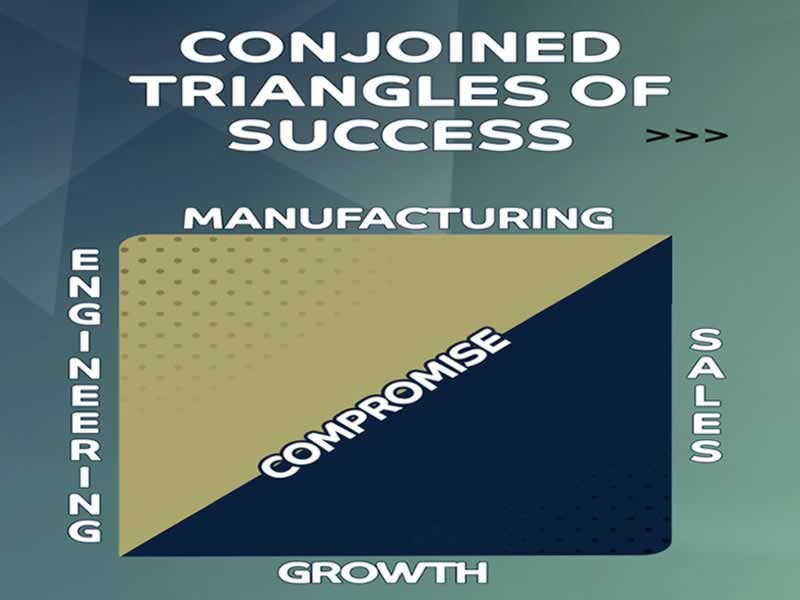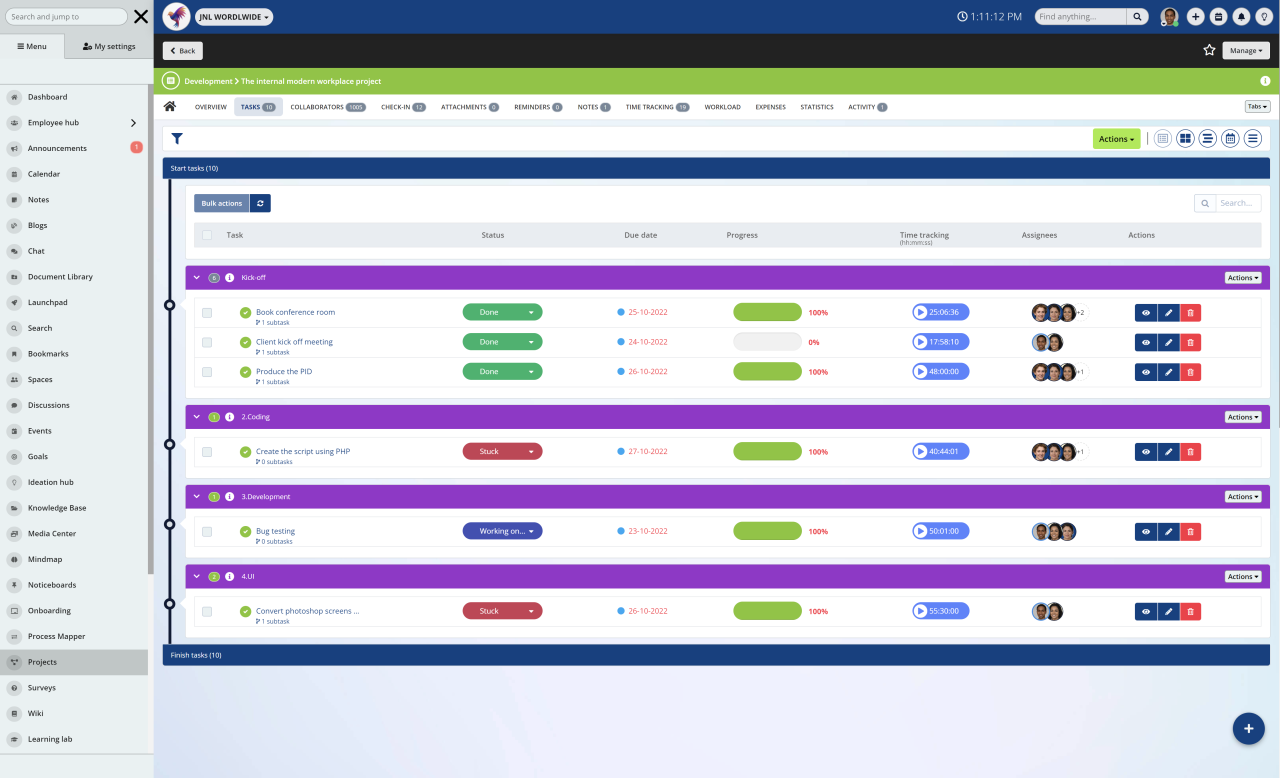Insight Blog
Agility’s perspectives on transforming the employee's experience throughout remote transformation using connected enterprise tools.
18 minutes reading time
(3510 words)
Conjoined Triangles Of Success | UPDATED 2024 | A Complete Guide
In this article, we will explain What Conjoined Triangles Of Success. Conjoined Triangles of Success and Silicon Valley Triangle of Success.
What is Conjoined Triangles Of Success?
In the pursuit of success, individuals often find themselves navigating a complex landscape of goals, challenges, and personal growth.
Imagine a guide that not only simplifies this journey but also provides a comprehensive framework for achieving success in various aspects of life. Enter the Triangle of Success, a concept that encapsulates the key pillars essential for personal and professional triumph.
This brief primer aims to shed light on this powerful model, offering insights into its components and the synergy between them.
A proven concept is the 'Triangle of Success', representing the three success ingredients: Knowledge, Skills, and Attitude.
We are familiar with words like competency, capability, capacity, potential, proficiency, etc., which are frequently used by us as substitutes for the word 'Ability'.
Ability = Function of KSAs (Knowledge + Skills + Attitude)
Where, Knowledge is practical information gained through learning, experience, or association. It is a prerequisite for learning skills. Skills, on the other hand, refer to the ability to perform specific tasks. Attitude involves how people react to certain situations and how they behave in general. We need KSAs to succeed in life.
A proven concept is the 'Triangle of Success', representing the three success ingredients: Knowledge, Skills, and Attitude.
We are familiar with words like competency, capability, capacity, potential, proficiency, etc., which are frequently used by us as substitutes for the word 'Ability'.
Ability = Function of KSAs (Knowledge + Skills + Attitude)
Where, Knowledge is practical information gained through learning, experience, or association. It is a prerequisite for learning skills. Skills, on the other hand, refer to the ability to perform specific tasks. Attitude involves how people react to certain situations and how they behave in general. We need KSAs to succeed in life.
In any field or aspect of life, to find the level of success, Knowledge, Skill, and Attitude are required. Without a strong work ethic, skills, and knowledge aren't as valuable.
In this article, we are going to delve into the pursuit of success through the lens of the "Conjoined Triangles of Success."
The John Wooden Pyramid of Success provides a structured framework outlining the specific behaviors essential for attaining personal satisfaction. Comprising 15 building blocks, these elements are organized into five interconnected levels. The initial level serves as the foundation and encompasses what Wooden describes as the "cornerstone traits."
We'll explore what this concept entails and why it holds significance. Let's dig a bit deeper into understanding the intricacies of this unique framework for achieving success.
Triangles Of Success: Knowledge
The first element is knowledge. Knowledge is not manifest in a wall full of diplomas and certificates. It's not accurately measured by a numeric grade point average or by years of workplace seniority. True knowledge equals understanding. In the case of leadership, understanding what our followers both need and expect from us provides practical working knowledge. Without such an understanding we are doomed to wander aimlessly from one irrelevant issue or activity to another.
There are two ways to acquire knowledge: by studying and by being around people who know more about something than we do. Both methods are useful
Triangles Of Success: Skills
The second component is skill. Is skill deemed more crucial than knowledge?
It would be accurate to assert that they are equally significant. Both knowledge and skill play vital roles in personal leadership development. In straightforward terms, skill translates to application. The capacity to apply a concept or idea to a task stands as a clear advantage in leadership.
Certain specific skills, such as professional courage, decisiveness, patience, and honest listening, can prove immensely beneficial in guiding followers. It's worth noting that each of these skills is acquirable through learning, but their benefits materialize only when actively applied.
Triangles Of Success: Attitude
And then there's attitude. Is attitude more or less important than knowledge and skill? It's not a matter of greater or lesser importance, but rather of equal significance. Attitude, alongside knowledge and skill, is a cornerstone of personal leadership development. In essence, attitude represents one's outlook and approach, influencing interactions and responses.
A positive attitude fosters resilience, adaptability, and a constructive mindset, all of which are invaluable traits in effective leadership. While knowledge provides understanding and skill offers practical application, attitude shapes the overall demeanor and impact of a leader.
In leadership, attitude encompasses qualities such as optimism, empathy, and the ability to inspire and motivate others. Cultivating a positive attitude is not only beneficial for personal growth but also instrumental in fostering a positive and productive team environment. It is an intrinsic element that, when combined with knowledge and skill, contributes to well-rounded and effective leadership.
What is Triangles Of Success
The "Triangles of Success" is a concept that emphasizes the interconnectedness of three key elements essential for achieving success in various aspects of life, particularly in personal development, career, and relationships. These three elements are commonly represented as the three points of a triangle, each contributing to and reinforcing the others. The concept suggests that a balanced and harmonious integration of these elements is crucial for overall success and fulfillment.
The history of the Triangles of Success can be traced back to self-help and personal development literature. It draws inspiration from diverse fields, including psychology, business, and philosophy, aiming to provide individuals with a holistic framework for achieving their goals. The idea behind the concept is to encourage individuals to assess and enhance these three key areas of their lives concurrently, fostering a more comprehensive and sustainable approach to success.
In terms of personal development, the Triangles of Success often encompass aspects such as self-awareness, emotional intelligence, and resilience. In the context of career, it may include skills development, networking, and goal setting. In relationships, the focus may be on communication, empathy, and building meaningful connections. The interconnectedness of these elements is emphasized to highlight that neglecting one aspect can have repercussions on the others, and true success involves a well-rounded and balanced approach.
Over time, the Triangles of Success have become a widely adopted framework in coaching, leadership development, and various self-help communities. It serves as a practical guide for individuals seeking a more integrated and holistic path towards personal and professional fulfillment. As Mikey Moran, founder of Private Label Extensions, explains, Clear internal communication and alignment around brand values are essential for scaling a business remotely. Our team's success depends on making sure every member feels connected to the bigger mission, even if they're working from different locations.
The history of the concept reflects a recognition of the multifaceted nature of success and the need for a comprehensive approach that addresses various dimensions of an individual's life.
Understanding The Conjoined Triangles of Success
The phrase "Conjoined Triangles of Success" is often associated with Elon Musk, the entrepreneur and CEO of SpaceX and Tesla. Musk introduced this concept to highlight the three key elements he considers crucial for achieving success in any endeavor.
The conjoined triangles represent three interdependent factors:
- Talent: Musk emphasizes the importance of having a talented and skilled team. Surrounding yourself with capable individuals who are experts in their respective fields is vital for the success of any project or business. A team with diverse talents and expertise can tackle challenges effectively and drive innovation.
- Drive: According to Musk, drive refers to an intense desire to achieve goals and a strong work ethic. It involves a relentless pursuit of objectives, even in the face of obstacles or failures. Having a motivated and hardworking team, including oneself, is essential for overcoming challenges and pushing the boundaries of what is possible.
- Execution: Execution is the ability to turn ideas and plans into tangible results. This involves effective project management, timely decision-making, and efficient implementation of strategies. Without proper execution, even the most talented team and the strongest drive may not lead to successful outcomes.
The conjoined triangles illustrate the interconnected nature of these three factors, highlighting that success requires a balance and integration of talent, drive, and execution.
Neglecting one aspect can compromise overall success. Musk often emphasizes the need for a cohesive team that possesses not only the right skills but also the determination and ability to execute plans effectively.
In summary, understanding and applying the Conjoined Triangles of Success involves building a talented team, fostering a strong drive to achieve goals, and ensuring efficient execution of plans and ideas.
In summary, understanding and applying the Conjoined Triangles of Success involves building a talented team, fostering a strong drive to achieve goals, and ensuring efficient execution of plans and ideas.
This framework is a guiding principle for Musk and serves as a valuable perspective for those aspiring to achieve success in their own ventures.
The Importance of Triangles Of Success
The concept of conjoined triangles for success encapsulates four crucial aspects that play a pivotal role in achieving favorable outcomes in various endeavors:
- Strategic Decision-Making: At the core of conjoined triangles for success is the need for strategic decision-making. This involves carefully analyzing options, understanding potential outcomes, and making informed choices. Strategic decisions set the direction for progress, ensuring a thoughtful and purposeful approach to achieving goals.
- Effective Planning: A significant aspect of success lies in effective planning. This involves outlining clear objectives, devising actionable plans, and allocating resources efficiently. Well-structured plans provide a roadmap for navigating challenges and capitalize on opportunities, contributing to a more streamlined and successful execution of tasks.
- Adaptability and Innovation: Conjoined triangles emphasize the importance of adaptability and innovation. Success often requires the ability to pivot when necessary and to embrace new ideas and approaches. Being open to change and fostering a culture of innovation enables individuals and organizations to stay ahead of the curve and navigate evolving landscapes successfully.
- Collaboration and Networking: Collaboration and networking form another integral aspect. Success is seldom achieved in isolation; it often thrives in a collaborative environment. Building meaningful connections, fostering partnerships, and leveraging collective knowledge and resources enhance the overall potential for success. Networking creates opportunities for learning, growth, and the exchange of valuable insights.
Understanding and integrating these four aspects – strategic decision-making, effective planning, adaptability and innovation, and collaboration and networking – can significantly contribute to the realization of success in various personal and professional pursuits.
The Application of Success Triangles
The application of the Conjoined Triangles of Success involves integrating the three key elements—Talent, Drive, and Execution—into various aspects of one's personal and professional life.
Here's how you can apply these principles for Success Triangle:
1.Building and Leading Teams:
1.Building and Leading Teams:
- Talent: Assemble a team with diverse skills and expertise relevant to your goals or projects.
- Drive: Foster a culture of motivation and commitment among team members, encouraging a shared passion for success.
- Execution: Implement effective communication channels, project management strategies, and decision-making processes to ensure plans are executed efficiently.
- Talent:Continuously invest in developing your own skills and knowledge to stay relevant and valuable.
- Drive: Cultivate a strong work ethic and set ambitious but achievable personal goals.
- Execution: Develop a structured approach to turning your ideas and plans into tangible results, ensuring consistency in your efforts.
- Talent:Surround yourself with experts in various domains, creating a dynamic and innovative environment.
- Drive: Embrace challenges with determination and resilience, viewing failures as opportunities to learn and grow.
- Execution: Implement agile and effective project management methodologies, adapting quickly to changing circumstances.
- Talent: Identify and leverage the strengths of individuals with diverse perspectives and skills.
- Drive: Approach problems with a proactive mindset, seeking solutions and opportunities for improvement.
- Execution: Implement well-thought-out solutions and monitor their effectiveness, adjusting as necessary.
- Talent: Ensure your strategic planning team possesses the necessary skills to analyze data, make informed decisions, and innovate.
- Drive: Foster a shared vision and commitment to the strategic objectives among all stakeholders.
- Execution: Develop and follow through on detailed plans, adapting as needed to achieve strategic goals.
- Talent: Foster a culture of learning and development, encouraging individuals to continuously enhance their skills.
- Drive: Instill a mindset of continuous improvement, where every success and failure becomes a learning opportunity.
- Execution: Regularly assess processes and outcomes, making adjustments to enhance efficiency and effectiveness.
In essence, the application of the Conjoined Triangles of Success involves a holistic approach to personal and professional development, emphasizing the interdependence of talent, drive, and execution in various contexts. Whether leading a team, pursuing personal goals, or navigating entrepreneurial endeavors, these principles provide a framework for achieving sustainable success.
Follow us and access great exclusive content everyday: Follow us on Google News
Is Silicon Valley's Triangle of Success Real?
The Silicon Valley's Triangle of Success is a concept that has been widely discussed and debated within the tech industry and beyond.
This metaphorical triangle typically encompasses three key elements: top-tier universities such as Stanford and UC Berkeley, venture capital firms with a strong presence in the region, and successful technology companies that have emerged from the area.
Proponents argue that the synergy among these three components creates an ecosystem that fosters innovation, entrepreneurship, and the rapid development of groundbreaking technologies.
The world-renowned universities supply a steady stream of talented graduates, venture capital firms provide the necessary funding for startups, and successful companies serve as both inspiration and potential acquirers of emerging ventures.
Critics, however, question the sustainability and inclusivity of the Silicon Valley model.
They argue that the high cost of living in the region, coupled with issues of diversity and inclusion, may hinder the broader success and accessibility of this ecosystem. The focus on a narrow demographic, both in terms of founders and employees, has led to concerns about a lack of diverse perspectives and ideas.
Additionally, as other regions around the world invest in creating their own innovation hubs, there is ongoing debate about whether Silicon Valley's dominance will persist or if it might be challenged by emerging tech ecosystems in places like China, Europe, or other parts of the United States.
Despite the ongoing discussions, it is undeniable that Silicon Valley has played a pivotal role in shaping the global technology landscape.
The success stories of companies like Apple, Google, and Facebook, which originated in the region, have set a benchmark for innovation and entrepreneurship. However, the evolving nature of the tech industry and the increasing interconnectedness of the global economy pose challenges to the traditional Silicon Valley model.
As technology continues to advance, the definition and geographical boundaries of success in the tech industry may undergo significant transformations, challenging the notion of the Silicon Valley Triangle of Success.
Conjoined Triangles of Success Poster
Conjoined Triangles of Success Poster: The "Conjoined Triangles of Success" poster is a humorous and iconic representation of the Silicon Valley startup culture. This satirical artwork gained popularity through the television series "Silicon Valley," created by Mike Judge. The poster features three interlocking triangles, each labeled with a facet of success in the tech industry. The first triangle represents "Idea," emphasizing the importance of a groundbreaking concept as the starting point for any successful venture.
The second triangle is labeled "Money," underscoring the critical role of funding and venture capital in turning innovative ideas into reality. This aspect highlights the Silicon Valley ecosystem's reliance on significant financial backing to support the development and growth of startups. The third triangle is labeled "Execution," emphasizing the need for effective implementation and operational excellence to bring an idea to fruition successfully.
The Conjoined Triangles of Success poster has become a symbol of the startup culture's idiosyncrasies and the challenges faced by entrepreneurs in the tech industry. Its popularity reflects a blend of satire and a keen observation of the dynamics within Silicon Valley, capturing the essence of what it takes to navigate the complex landscape of innovation, funding, and execution in the pursuit of success.
The poster has become a cultural reference, resonating not only with those directly involved in the tech world but also with a broader audience interested in the quirks and intricacies of the startup ecosystem.
You may also like: Best Apps for Employees: UPDATED 2022 – A Complete Guide
Benefits Of Conjoint Triangles Of Success
Understanding the conjoined triangles of success yields numerous advantages, essential for a comprehensive grasp of its significance. Familiarity with these benefits can significantly ease your path in the long run.
- Industriousness: Work Ethic: Stresses the importance of hard work, dedication, and persistence, fostering discipline and consistency in the pursuit of goals. Preparation: Being industrious ensures thorough preparation, enhancing the probability of success in any endeavor.
- Enthusiasm: Positive Attitude: Cultivates a positive mindset, resilience, and the ability to rebound from setbacks. Motivation: Acts as a driving force, keeping you passionate and engaged in your pursuits, resulting in heightened productivity.
- Skill: Competence: Developing skills and expertise in a specific field enhances your capability to perform tasks efficiently and effectively. Confidence: Mastery of skills boosts self-confidence, empowering you to tackle challenges with increased assurance and poise.
The amalgamation of these elements creates a robust foundation for personal and professional success. Industriousness instills the necessary work ethic, enthusiasm provides the ongoing drive, and skill ensures competence in executing tasks.
Together, they establish a powerful framework for achieving success across various facets of life.
Free ebook: How To Get Your Intranet Off The Ground
Project management triangle
The Project Management Triangle, also known as the Triple Constraint or Iron Triangle, is a fundamental concept used by project managers to effectively balance and optimize project outcomes. It consists of three interrelated constraints: time, cost, and scope. These constraints represent the key factors that influence the success of a project.
- Time: This refers to the project's schedule or the timeframe within which it needs to be completed. Efficient time management is crucial to ensure that the project meets its deadlines and milestones. Delays in project completion can have cascading effects on other aspects of the project.
- Cost: Cost is the financial aspect of the project, encompassing the budget allocated for its execution. Managing costs involves controlling expenditures, allocating resources judiciously, and preventing budget overruns. Effective cost management is essential for the project's financial viability and overall success.
- Scope: Scope defines the specific objectives, requirements, and features that the project aims to deliver. It encompasses the project's boundaries and the work that needs to be accomplished. Managing scope involves ensuring that the project stays within its defined parameters and meets the agreed-upon deliverables.
Why Is the Project Management Triangle Important?
The project management triangle is a valuable tool for several reasons:
- Balancing Constraints: Project managers must strike a balance among time, cost, and scope. Adjusting one constraint often impacts the others. For instance, accelerating a project timeline may increase costs or reduce the scope. Understanding this interdependence helps in making informed decisions.
- Risk Management: By actively managing the project triangle, project managers can identify potential risks and mitigate them early in the project life cycle. This proactive approach minimizes the likelihood of unexpected issues arising during execution.
- Change Management: The triangle provides a framework for evaluating and implementing changes. When changes are proposed, project managers can assess their impact on time, cost, and scope, allowing for informed decision-making and effective change management.
- Client Communication: The project management triangle serves as a visual representation of project constraints, making it easier for project managers to communicate with clients. Clients can gain insights into the trade-offs involved and make informed decisions based on their priorities.
In essence, the Project Management Triangle is a guiding principle that helps project managers navigate the complexities of project execution, promoting successful outcomes through effective management of time, cost, and scope.
Tools to Manage the Project Management Triangle
Amidst the abundance of project management tools accessible to businesses, it's imperative for project managers to scrutinize the features closely to ensure alignment with their specific requirements. For instance, monday.com proves to be an optimal choice for teams seeking an affordable solution to manage the three constraints of a project.
AgilityPortal provides specialized tools for Agile teams, facilitating the tracking of constraints during product iterations. On the other hand, Teamwork emerges as the ideal tool for effectively managing constraints within client-facing teams.
Let's delve deeper into AgilityPortals ability to assist you in navigating and optimizing your project management triangle:
AgilityPortal
AgilityPortal is an intranet software that uniquely incorporates project management features tailored for client-facing teams, ensuring seamless fulfillment of project requirements.
Clients have the ability to join the platform, enabling real-time tracking of project success and the opportunity to provide comments for ongoing clarity regarding the project's scope.
Additionally, for the effective management of time constraints, freelancers can be added at no cost through the "unlimited collaborators feature." The inclusion of budget tracking further empowers users to adeptly handle cost constraints.
Wrapping up
In conclusion, these principles form the essence of the conjoined triangles of success. It is imperative to make informed choices, ensuring that strategic decisions are not made blindly. The key lies in the judicious application of strategies rather than stumbling in the dark while implementing business tactics.
Crafting well-thought-out plans is crucial for simplifying and enhancing the effectiveness of your business endeavors.Avoid unnecessarily complicating matters. The success of achieving your goals is closely tied to the precision of your choices. By consistently making informed decisions in the right direction, you pave the way for a more successful and fruitful journey toward your objectives.
Categories
Blog
(2584)
Business Management
(318)
Employee Engagement
(204)
Digital Transformation
(171)
Intranets
(119)
Growth
(117)
Remote Work
(61)
Sales
(48)
Collaboration
(37)
Culture
(29)
Project management
(29)
Customer Experience
(26)
Knowledge Management
(21)
Leadership
(20)
Comparisons
(5)
Ready to learn more? 👍
One platform to optimize, manage and track all of your teams. Your new digital workplace is a click away. 🚀
Free for 14 days, no credit card required.
















